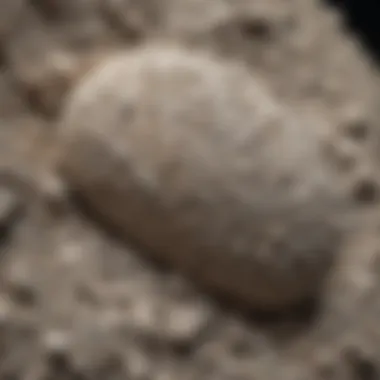Exploring Pumice: Fascinating Volcanic Rock Insights


Intro
Pumice is not just another rock; it is a remarkable product of volcanic activity that holds intriguing properties. Formed during explosive eruptions, it is characterized by its lightweight and porous nature. This article aims to explore pumice from various angles, emphasizing its geological origins, unique characteristics, and wide-ranging applications. Additionally, we will examine the environmental aspects of pumice mining and its place within natural ecosystems. Rock and fossil collectors, as well as enthusiasts, will find a treasure trove of knowledge about this fascinating geological material.
Featured Collectible of the Month
Overview
For collectors, pumice is a unique item to consider due to its availability and distinctive features. The texture and color can vary significantly, depending on the mineral composition and the conditions under which it formed. Some pumice stones showcase beautiful shades of gray, white, and even faint pink. These variations can elevate the aesthetic appeal, making pumice an attractive collectible.
Historical Significance
Pumice has a history that dates back thousands of years. Ancient civilizations utilized pumice in construction and beauty products. The Romans, for instance, employed pumice as a lightweight aggregate in their concrete, contributing to the durability of many ancient structures. The varied uses of pumice throughout history reflect its significance beyond mere aesthetics and delve deeper into practical applications.
Identification Techniques
Visual Characteristics
When identifying pumice, certain visual traits are essential. Pumice stones are typically light in weight and exhibit a rough, granular texture. A careful look reveals tiny bubbles within the rock, a result of gas escaping during solidification. Often, the surface can appear dull but may have glittering mineral inclusions. Its color varies, but a pale appearance is most common.
Resources for Identification
To assist collectors in identifying pumice, several online resources are available:
- Wikipedia for geological details and definitions.
- Britannica offers concise insights into the formation and uses of pumice.
- Online forums, such as Reddit and Facebook, provide platforms for collectors to share their experiences and knowledge.
"Understanding the characteristics of pumice opens up a world of appreciation for this volcanic wonder."
Prelude to Pumice
Pumice represents a fascinating component of volcanic geology, possessing unique physical and chemical properties. Its formation, derived from explosive volcanic eruptions, provides insights into the earth's geological processes. This significance extends beyond its scientific connotations; pumice is applicable in various industries, showcasing its versatility. By understanding pumice, we can appreciate both its natural origins and its numerous practical uses.
Definition and Basic Properties
Pumice is a light and porous volcanic rock, characterized by its glassy texture. It typically forms when volcanic lava cools rapidly due to explosive eruptions. This rapid cooling process traps gas bubbles inside the lava, resulting in a rock that can float on water.
Some of the basic properties of pumice include:
- Density: Pumice has a lower density than most rocks, which allows it to float. It usually ranges from 0.5 to 1.0 grams per cubic centimeter.
- Porosity: The numerous gas bubbles embedded within the rock contribute to its high porosity, sometimes exceeding 90%. This property is valuable in construction and horticulture.
- Color Variations: Pumice can vary in color, often appearing in shades of gray, white, and even green or pink, depending on the mineral content. This variety can appeal to collectors and artists alike.
Historical Significance of Pumice
Historically, pumice has been utilized by many cultures for various purposes. Its abrasiveness made it an effective tool for grinding and polishing, used in ancient Egypt for cosmetic purposes and stone carving. In Roman times, pumice was key in the construction of concrete, allowing for the creation of architectural marvels that still stand today.
Additionally, pumice has played a role in agriculture. Ancient farmers recognized the benefits of pumice's abilities to aerate soil and retain moisture. To this day, pumice is still used in gardening, often mixed with soil to improve aeration and drainage.
"Pumice remains an essential resource, bridging the gap between ancient practices and modern applications."
This historical context underscores the importance of understanding pumice not just as a geological entity but also as a material deeply tied to human development and industry.
Geological Formation of Pumice
The geological formation of pumice is crucial in understanding this unique volcanic rock. Pumice is not just a geological curiosity; it embodies significant processes that shape our Earth's surface. Learning about how pumice is formed offers insights into volcanic activity and presents a window into the earth's inner workings. This understanding is particularly relevant for rock and fossil collectors, as the characteristics and origins of pumice can greatly influence its desirability and value.


How Pumice is Formed
Pumice forms as a result of explosive volcanic eruptions. When magma rises to the Earth’s surface, various gases, mostly water vapor and carbon dioxide, become dissolved within it under high pressure. As the magma erupts, the sudden decrease in pressure allows these gases to escape rapidly, creating numerous bubbles within the lava. This process results in a foamy texture and, once cooled, solidifies to form pumice.
The rapid cooling of lava that occurs during an eruption is pivotal. The cooling process happens quickly enough that the gas bubbles do not escape, leading to the characteristic light, porous texture of pumice. This volcanic rock can vary widely in density and texture, depending on the conditions during its formation, such as eruption type and cooling rates.
Comparison with Other Volcanic Rocks
When comparing pumice with other volcanic rocks, several distinct features stand out. Notably, pumice is lighter than many other volcanic rocks like basalt and andesite. This unique buoyancy allows pumice to float on water, a trait not shared by denser volcanic products.
Other key comparisons include:
- Texture: Pumice has a porous, frothy structure, while rocks like obsidian are glassy and smooth.
- Formation Conditions: Pumice is formed from explosive eruptions, in contrast to lava flows that create denser rocks like basalt.
- Uses: Pumice is used in a variety of applications including abrasives and lightweight construction material, whereas other volcanic rocks may be more suited for decorative purposes.
"The formation of pumice is a reminder of the dynamic processes shaping our planet through volcanic activity and represents a critical resource in both industry and nature."
Understanding pumice in relation to other volcanic rocks enhances the appreciation of its geological significance for enthusiasts. Each type of volcanic rock serves different roles in nature and human use, making this exploration into the formation of pumice an essential part of the broader study of geology.
Characteristics of Pumice
Understanding the characteristics of pumice is crucial for various applications across different industries. Pumice's unique properties make it an efficient material for construction, industrial processes, and even cosmetic products. These attributes not only highlight the rock's versatility, but also its significance in environmental systems. Let's examine some of the core characteristics that define pumice.
Physical Properties
Density
Density is a significant feature of pumice. This volcanic rock is notably light, a fact that stems from its formation process, where gas bubbles are trapped in the lava as it cools. The low density can range from about 0.3 to 0.8 grams per cubic centimeter. This characteristic makes it highly favored in construction, as it contributes to reduced weight in building materials. The lightweight nature is not just beneficial for transportation but also for structural stability in certain applications. It is important to note that while low density offers advantages, it may also come with considerations regarding compressive strength for some uses.
Porosity
Porosity refers to the empty spaces within the pumice rock, and it ranges significantly based on the specific sample. The porosity of pumice contributes directly to its usability. Higher porosity allows pumice to absorb water and other liquids, which is essential in applications like horticulture for soil aeration. On the other hand, excessive porosity can weaken the structural integrity of pumice when used in construction. It allows for efficient drainage, but it is vital to consider the balance required for different uses in agriculture versus construction.
Color Variations
Pumice occurs in various colors, primarily light shades of gray, white, or cream due to the minerals present during formation. This aspect of pumice adds value aesthetically, particularly in cosmetic and decorative applications. The color can provide clues about its mineral content. For example, darker colors may indicate higher iron content, while lighter, more porous varieties are often sought after for their visual appeal. However, aesthetic applications should not overshadow the functional qualities of pumice, as not all colors may perform similarly in industrial uses.
Chemical Composition
The chemical composition of pumice includes a mix of silica, alumina, and a range of metal oxides like iron and magnesium. Silica content typically sits between 60% and 75%. This composition is vital to understanding the durability and stability of pumice across various applications. The mineral composition also plays a crucial role in interactions during chemical processes, making pumice an interesting candidate for filtration systems where impurities need to be captured.
Overall, the characteristics of pumice contribute to its wide range of uses and its importance in environments where efficient materials are necessary. The interplay between its physical and chemical properties ensures that this volcanic wonder continues to be a relevant subject in geology and beyond.
"Pumice showcases the extraordinary result of volcanic activity, linking natural processes with practical benefits."
This exploration into the physical and chemical traits of pumice sets the stage for understanding its applications in various fields.
Applications of Pumice
Pumice is not only a fascinating geological product but also a material of great utility in various fields. Its unique properties make it invaluable in construction, industry, and cosmetic applications. This section outlines the significant ways pumice is employed, emphasizing the benefits and considerations of its varied uses. The adaptability of pumice in these applications showcases its importance and relevance in both economic and environmental contexts.
Pumice in Construction
Lightweight Aggregate


Lightweight aggregate is one of the most compelling uses of pumice in construction. Due to its low density, pumice serves as an ideal component in concrete production. This quality helps reduce the overall weight of structures, resulting in less demand for robust foundations. The key characteristic that defines pumice as a lightweight aggregate is its cellular structure, which traps air and minimizes weight without sacrificing strength.
This feature of pumice makes it a beneficial choice, allowing builders to create structures that are both durable and lighter. However, one consideration is the cost during sourcing and processing. While pumice is often more expensive than traditional aggregates, the benefits in lightweight construction are undeniable. The ease of transport and reduced strain on structural materials can offset initial expenses in the long term.
Insulation Material
Pumice also functions effectively as an insulation material. Its thermal resistance is noteworthy, making it suitable for applications in both walls and roofs. This quality is crucial in maintaining energy efficiency within buildings, as pumice can help regulate temperature. The unique feature of pumice insulation is its natural ability to resist heat transfer, aiding in sustainability efforts within construction.
Despite its advantages, pumice insulation may not always be as readily available as conventional materials. Some builders might encounter challenges in finding sufficient supply, which can delay projects. However, the environmental benefits and insulation properties make pumice a favored choice among eco-conscious developers.
Industrial Uses
Abrasives
In industrial contexts, pumice is widely used as an abrasive material. Its natural hardness and coarse texture make it effective in smoothing and polishing surfaces. This key characteristic allows pumice to be used in various cleaning products and abrasive tools. Its ability to gently abrade materials without causing significant damage is a significant benefit.
Because of these features, pumice abrasives are popular in manufacturing and maintenance industries. They often serve as an eco-friendly alternative to synthetic abrasives. However, they may require careful handling, as improper use can lead to quick wear and lower effectiveness.
Filtration
Filtration is another crucial application of pumice. Its porous nature allows it to serve as an effective filter medium in various industries, including water purification. The key characteristic of pumice used in filtration systems is its high surface area, which enhances the filtering capabilities. This quality makes pumice popular in both municipal and industrial water treatment plants.
While pumice is highly effective, its use might require additional processes for optimal performance, such as pre-treatment to remove impurities. Still, the advantages of using pumice in filtration are evident, providing a natural, efficient solution to water clarity and quality challenges.
Cosmetic Applications
Exfoliation Products
Pumice is also an ingredient in many beauty and skincare products, particularly in exfoliation. The natural abrasiveness of pumice makes it an excellent choice for scrubs designed to remove dead skin cells. This key characteristic promotes smoother skin and can improve overall texture. The use of pumice in exfoliation products is beneficial, as it allows for a more gentle yet effective treatment compared to harsher synthetic materials.
However, users should be cautious, as over-exfoliation can occur if products are used too frequently or aggressively. It is important to follow recommended guidelines to maximize benefits without causing irritation.
Skin Treatments
Beyond exfoliation, pumice is utilized in various skin treatments. Its ability to gently smooth rough areas makes it a popular ingredient in creams and pastes aimed at treating calluses and thickened skin. The unique feature of pumice in skin treatments is its capacity to provide results without harsh chemicals. This quality makes it a preferred choice among individuals seeking natural skincare solutions.
Nonetheless, while pumice can assist in skin rejuvenation, it may not be suitable for all skin types. Sensitive individuals should test products with pumice carefully to prevent adverse reactions.
Environmental Impact of Pumice Mining
Pumice mining, while often overlooked, has significant effects on the environment. The extraction of this volcanic rock can lead to disturbances in local ecosystems, which may have long-lasting consequences. Understanding these impacts is crucial for balancing economic benefits with ecological responsibility. This section will shine a light on the specific ecological effects of pumice mining and explore sustainable practices that can be adopted.
Ecological Effects
The ecological effects of pumice mining can vary depending on the scale and method of extraction. When large areas are excavated, the natural landscape is altered. Plant life is often uprooted, disrupting the habitats of local fauna. The removal of vegetation can lead to soil erosion, making it easier for rain to wash away the topsoil. This can have a cascading effect, as it may impact water quality in nearby streams and rivers.
Moreover, the loss of biodiversity is a pressing concern. Many species depend on specific habitats that are disrupted by mining operations. The decline in these species can lead to imbalances in the ecosystem.
Another consideration is dust emissions from mining activities. This dust can affect air quality and may impact the health of nearby communities. It can also settle on surfaces, altering the local environment further. Therefore, careful management of pumice mining operations is essential to mitigate these ecological effects.
Sustainable Practices in Pumice Extraction
As awareness of environmental issues grows, the importance of sustainable practices in pumice extraction has become clearer. Implementing environmentally-friendly methods can help minimize the impact of mining on local ecosystems.


- Selective Mining: Instead of removing large swathes of land, selective mining involves extracting pumice from specific areas without extensively disturbing surrounding habitats. This method helps to preserve more of the local flora and fauna.
- Rehabilitation of Disturbed Areas: After mining operations are completed, companies can engage in rehabilitation efforts. This includes replanting native vegetation, which helps restore the ecosystem and combat erosion.
- Water Management Strategies: Implementing systems to manage water runoff can significantly reduce soil erosion and sedimentation in nearby water bodies. Retaining structures and sediment basins can help filter out sediments before they enter natural waterways.
- Regulatory Compliance: Following local and international environmental regulations can lead to better outcomes for ecosystems affected by pumice mining. This includes conducting environmental assessments before beginning operations.
- Community Engagement: Involving local communities in decision-making processes can ensure that the interests of those who live near mining sites are considered. Their knowledge can be invaluable in developing effective sustainable practices.
By embracing sustainable practices, the pumice mining industry can mitigate its ecological impact while continuing to provide valuable resources.
Pumice in the Collecting Community
Pumice, a fascinating volcanic rock, holds a distinctive place in the hearts of rock and mineral collectors. Its varied textures and colors appeal to both serious enthusiasts and casual hobbyists. Collecting pumice is not just an activity; it represents a connection to geological events that have shaped our planet. This section explores key elements about collecting pumice, from techniques to considerations that enhance the collecting experience.
Collecting Pumice: A Guide
When starting a pumice collection, it is essential to know what to look for. Here are some tips for collectors:
- Research Local Sources: Identifying where pumice can be found is crucial. Many areas near active or dormant volcanoes offer sites for collection. Researching historical eruption sites can lead to fruitful discoveries.
- Tools Needed: Simple tools like a sturdy bag for collection, a sieve for separating pumice from surrounding material, and proper gloves for safety can enhance the process.
- Identification Skills: Learning how to identify quality pumice is imperative. Look for pieces that are lightweight, have a porous texture, and display interesting colors or patterns. Each specimen tells a story of its origin.
- Ethical Collecting: Always follow guidelines for responsible collecting. Avoid taking pumice from protected sites, and respect local regulations regarding rock collecting. Consider leaving some pieces behind for future collectors and the natural ecosystem.
Notable Locations for Pumice Collecting
There are several well-known locations that enthusiasts frequent to find pumice. Some of these include:
- Mount St. Helens, USA: Following its explosive 1980 eruption, Mount St. Helens produced a vast amount of pumice. The area remains popular among collectors today.
- Pumice Stone Quarries, Italy: Italy has a rich history of pumice extraction, particularly in regions like Lipari. Collectors can find stunning specimens here.
- Santorini, Greece: The volcanic island of Santorini offers not only breathtaking views but also abundant pumice. Its unique geological features provide a variety of collecting options.
- Iceland: Known for its dynamic geology, Iceland is rich in pumice deposits. Collecting here gives a chance to explore diverse volcanic landscapes.
"Pumice collecting is more than a hobby; it connects collectors to the raw power of nature."
In summary, pumice collecting enriches the understanding of geology and provides a tangible link to volcanic activity. By following ethical practices and exploring notable locations, enthusiasts can build a collection that reflects the beauty and science behind this unique rock.
The Future of Pumice Research
As we venture into the future of pumice research, it is crucial to understand the multidimensional benefits this volcanic rock can provide. The ongoing scientific inquiry into pumice not only enhances our understanding of geological phenomena but also reveals innovative applications that can benefit various industries. By focusing on advancing our knowledge of pumice, researchers can uncover new methods of utilization, improving both economic and environmental outcomes.
Innovative Uses of Pumice
Emerging studies highlight several innovative uses of pumice that could shape future applications. For instance, researchers are exploring pumice's potential in agriculture. Its lightweight porous structure enhances soil aeration, which can lead to improved plant growth. This versatility can also extend to organic farming practices where pumice serves as a natural amendment.
Furthermore, the construction industry is witnessing new approaches to utilize pumice as a sustainable building material. Researchers are experimenting with pumice-based composites that can reduce the overall weight of structures while providing superior insulation properties. Such advancements could help in building more energy-efficient houses and infrastructures.
Other areas worth noting include environmental remediation. Scientists are investigating pumice as an effective filtering medium for treating wastewater due to its high porosity. Its natural properties can purify water while minimizing chemical use, thus promoting sustainability.
Research Trends in Volcanology
Another vital aspect of pumice study is the evolving research trends in volcanology. Volcanologists are increasingly focusing on the relationship between pumice and volcanic activity, aiming to understand eruption processes better. Insights gained from these studies could lead to improved eruption prediction methods, benefiting populations living in volcanic regions.
Additionally, the study of pumice deposits aids researchers in comprehending past geological events. This can illuminate patterns of volcanic activity, providing valuable data for predicting future eruptions. The combination of historical analysis and real-time monitoring is essential in building a comprehensive framework for volcanic hazard assessment.
Moreover, novel technologies like remote sensing and geospatial analysis are revolutionizing the ways in which pumice research is conducted. Geoscientists leverage these tools to gather data proactively, creating detailed models of volcanic deposits and their behaviors.
In summary, the future of pumice research presents numerous pathways that could enhance environmental sustainability and safety. By delving deeper into this volcanic wonder, scientists and industries alike can tap into its potential, creating applications that could serve humanity while respecting the natural world.
Culmination
Pumice represents a unique intersection of geological processes and human utility. The exploration of pumice serves both scientific and practical purposes, connecting a broad audience of geologists, collectors, and enthusiasts. Understanding pumice's attributes and applications is important not only for appreciating its role in nature but also for recognizing its societal benefits. In evaluating the extraction processes, it is crucial to consider sustainable practices that mitigate ecological damage.
Summary of Key Points
- Formation and Characteristics: Pumice is formed through explosive volcanic activity, creating a lightweight, highly porous material. Its unique physical and chemical properties make it relevant across several industries.
- Applications: From construction to cosmetics, pumice is utilized in various ways. Its lightweight nature makes it ideal for building materials, while its abrasive qualities find roles in beauty products.
- Environmental Considerations: Pumice mining can have significant ecological impacts. Sustainable extraction methods are essential to minimize harm to the environment.
- Future Research: The study of pumice is evolving, showing potential for innovative uses. Ongoing research in volcanology is deepening our understanding of these materials and their applications.
Final Thoughts on Pumice and Its Importance
Ultimately, pumice is more than just a volcanic rock. It embodies a fascinating geological history and a wide array of functional applications. Its relevance spans multiple fields, from construction and industry to skincare and environmental sustainability. Understanding this material leads to greater appreciation of our planet’s geological activities and their ongoing influence on human life. Collectors, in particular, have a stake in recognizing its variety, beauty, and historical significance.
"Pumice is not just a geological curiosity but a bridge between nature and humanity's quest for resources."
As we continue to explore the diverse applications and implications of pumice, it becomes evident that this volcanic wonder holds a profound place in both nature and our modern world.



